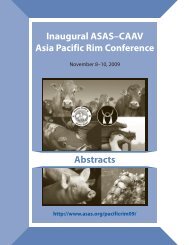PROCEEDINGS - American Society of Animal Science
PROCEEDINGS - American Society of Animal Science
PROCEEDINGS - American Society of Animal Science
Create successful ePaper yourself
Turn your PDF publications into a flip-book with our unique Google optimized e-Paper software.
incoming students have hands-on experience with food<br />
animals.<br />
New Issues. All eras <strong>of</strong> food animal production have<br />
dealt with issues. However, following the green<br />
revolution (when concern for the capacity to produce<br />
food diminished) many highly funded activist groups<br />
now target the food animal industry. Many academic<br />
units have developed programs that focus on food safety,<br />
animal care and environment.<br />
Politics. The political scene has had an increasingly<br />
greater impact on animal agriculture during the past 30<br />
years. Pr<strong>of</strong>essional societies, clientele groups and<br />
universities now have PACs and/or lobbyists to liaison<br />
with state and federal government.<br />
Because <strong>of</strong> these issues, administrators have<br />
responded with a variety <strong>of</strong> decisions. The challenge<br />
should be to deal with difficult issues without losing site<br />
<strong>of</strong> the goal: namely, to maintain balanced programs and<br />
serve stakeholders.<br />
Maintaining Balance When Shift Happens<br />
Land Grant institutions should be dynamic but the<br />
principle <strong>of</strong> balanced teaching, research, and extension<br />
programs to serve stakeholders must be maintained.<br />
Strategic planning and change has been a popular theme<br />
during the past three decades. We have witnessed<br />
“change merchants” in university administration that<br />
jump on any bandwagon labeled as change. Change<br />
almost became a competition among some<br />
administrators. In some cases, it appeared that there was<br />
little concern for impact <strong>of</strong> decisions on maintaining<br />
balanced programs and serving the best interests <strong>of</strong><br />
stakeholders. Dealing with the issues listed earlier<br />
requires leadership with vision and understanding. It<br />
requires leadership that considers input from students,<br />
faculty, staff and most <strong>of</strong> all from stakeholders.<br />
Administrative responses to shifts are described below.<br />
Adopting electronic technology. Moving rapidly to<br />
electronic communications in all phases <strong>of</strong> university<br />
programs was not a choice; it was a mandate by society!<br />
It happened quickly. The first year email addresses were<br />
published in the Colorado State University (CSU)<br />
Directory was 1992-93! Moreover, in a relatively short<br />
time faculty, students, administrators, staff and<br />
stakeholders now use electronic communications for a<br />
multitude <strong>of</strong> purposes. We submit research reports,<br />
search for research articles, enroll students, use Web CT<br />
and deliver information to clientele on a regular basis<br />
using electronic media. Classrooms are equipped with<br />
computer terminals where instructors use PowerPoin t,<br />
video and web generated teaching aids. Email is the<br />
standard for letters and legal correspondence to students.<br />
Electronic technologies appear to have improved<br />
program balance and successfully served stakeholders.<br />
Dealing with Reduced Funding. Funding reduction<br />
is perhaps the most difficult issue faced by higher<br />
administration. The general approach has been to<br />
increase revenues by increasing research grants, tuition<br />
and fund raising and to reduce costs wherever possible.<br />
These approaches for solving fiscal problems all have the<br />
potential to create imbalances in programs and<br />
reductions in service to stakeholders.<br />
With the recession <strong>of</strong> 1982, budget issues at CSU<br />
were evident. In 1981 the Dean first imitated a switch<br />
from 12 to 9-month appointments as a tool to buffer<br />
budget cuts. Of course, administrators remained 12-<br />
month employees! For <strong>Animal</strong> <strong>Science</strong> departments the<br />
9-month appointment was first adopted at the University<br />
<strong>of</strong> Illinois and true to form, many Deans jumped on<br />
board. The original selling points were (1) less<br />
opposition from academic departments across campus,<br />
(2) that agriculture faculty would receive a 9-month<br />
salary equal to their 12-month salary and (3) more grant<br />
dollars would result because faculty could increase<br />
annual income with two additional month’s salary from<br />
external funds! However, many universities did not<br />
convert from 12 to 9 with the same salary and extension<br />
faculty were also an issue. In 1990, CSU held an Ag<br />
Department Head’s retreat to discuss a survey from 19<br />
Land Grant universities relative to converting from 12 to<br />
9-month appointments. Most <strong>of</strong> the 19 surveyed<br />
universities’ representatives did not support conversion.<br />
Extension faculty and limits on the federal retirement<br />
system, ability to serve stakeholders and finding summer<br />
funding were the most common concerns listed.<br />
However, by the mid 90s many new appointments at<br />
CSU were 9-month. Currently CSU mandates 9-month<br />
appointments for all new faculty in agriculture including<br />
extension. Concerns with summer funding (after 2 years<br />
<strong>of</strong> full funding) takes precedent over serving<br />
stakeholders. This is understandable as they have<br />
families to support. Anticipated increase in grant dollars<br />
(and indirect cost recoveries) is the major factor now<br />
driving the 9-month system. In a telephone survey <strong>of</strong> 10<br />
WSASAS <strong>Animal</strong> <strong>Science</strong> Departments, only CSU<br />
currently mandates 9-month appointments for all new<br />
faculty although several reported a variety <strong>of</strong><br />
appointment types depending on source <strong>of</strong> funds.<br />
Many <strong>of</strong> the changes that have occurred in the past<br />
3 decades are based on increasing external grants and the<br />
assumption that this will result in increased indirect cost<br />
recovery. University administration view indirect costs<br />
(<strong>of</strong>ten-termed overhead or facility and administration
















